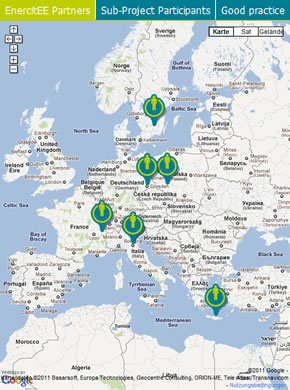Regionale Abschlussveranstaltung „Sachsen trifft Europa: Innovative Ergebnisse für mehr Energieeffizienz in Kommunen und bei den Bürgern
Das europäische Energieeffizienzprojekt EnercitEE zieht Bilanz nach mehr als dreijähriger erfolgreicher Arbeit. Bei einer regionalen Abschlussveranstaltung am 13.06.2013 in Dresden Hellerau wurden viele innovative Lösungen und Instrumente aus den 10 Teilprojekten präsentiert.
Themenschwerpunkte waren dabei energieeffiziente Gebäude, Bewusstseinsbildung und Sensibilisierung, Finanzierungsmodelle und –programme sowie konzeptionelle und planerische Maßnahmen für die Kommunalverwaltung. Viele dieser Ergebnisse sind übertragbar und stehen nun Kommunen, Bürgern und anderen interessierten Akteuren zur Weiternutzung zur Verfügung.
GRACE was presented at the IEPEC conference
GRACE was presented through a poster presentation in the framework of the IEPEC conference (International Energy Program Evaluation Conference) held in Rome from 12 to 14 June 2012.
More than 140 participants from 24 countries participated in that conference.
AESS, along with partners contributions, developed the poster about the first GRACE’s results. The poster was illustrated by Mr Antinucci on 12 June and reports – along with a brief energy profile of each region – about cost benefits of 3 incentives/grants programmes in the 3 regions involved: Passive House in Saxony (DE), Solar thermal collectors in Lower Silesia (PL) and regional 55% tax rebate in Emilia-Romagna (IT).
Written by Marcello Antinucci
GRACE – Analysis of funding programmes for citizens and communities
In Germany and especially in Saxony there are many funding programmes which support the energy efficiency of citizens and communities. Within the EnercitEE sub-project GRACE three funding programmes will be analysed in detail. The aim is to find out the effect of the programmes in that way that we are able to make a statement how many CO2 emissions respectively energy is saved with 1 € out of the funding programme.
One of the selected programmes is the Saxon Passive house programme. It is part of the Saxon Energy and Climate Protection Programme. The Passive house programme supports builders of passive houses with a grant of 100 €/m² based on the energy reference area. For refurbishment of buildings with passive house components the beneficiaries get a grant of 130 €/m² energy reference area. Both grants are non repayable. In Saxony the Passive house programme was used by 136 beneficiaries since 2007. In comparison with the standard EnEV building the passive house saves much more energy. The EnEV house is a standard in Germany. All builders of new houses have to follow this regulation. An amendment of this standard is planned for 2012, which means stricter rules for future homeowners. In the diagram below, there is a comparison between an EnEV house of 2009 and a passive house with 150 m² each. In addition it is assumed that the rate of energy price increase has a level of 5 % per year. All in all the beneficiary saves more than 20,000 € until year 30 after building and nearly 90,000 € until year 50 after building the passive house in that scenario.

Kick-off-meeting of the EnercitEE sub-project GRACE
The kick-off-meeting of the sub-project GRACE was held from 12th to 13th July 2011 in Bautzen.
Sub-project partners from the Italian region Emilia- Romagna and from Lower Silesia, Poland participated in the 1st GRACE meeting. The kick-off-meeting was opened by the welcome address from Christina Mante from the Saxon State Office for Environment, Agriculture and Geology. She introduced EnercitEE and explained the structure and objectives of this INTERREG IVC project.
Results of sub-project evaluation 2nd Call
The EnercitEE partner regions have assessed the six applications received under the 2nd Call for Proposals. A decision was taken on 6 April 2011 at the Working and Steering Group Meeting in Växjö. The EnercitEE Steering Group decided:








